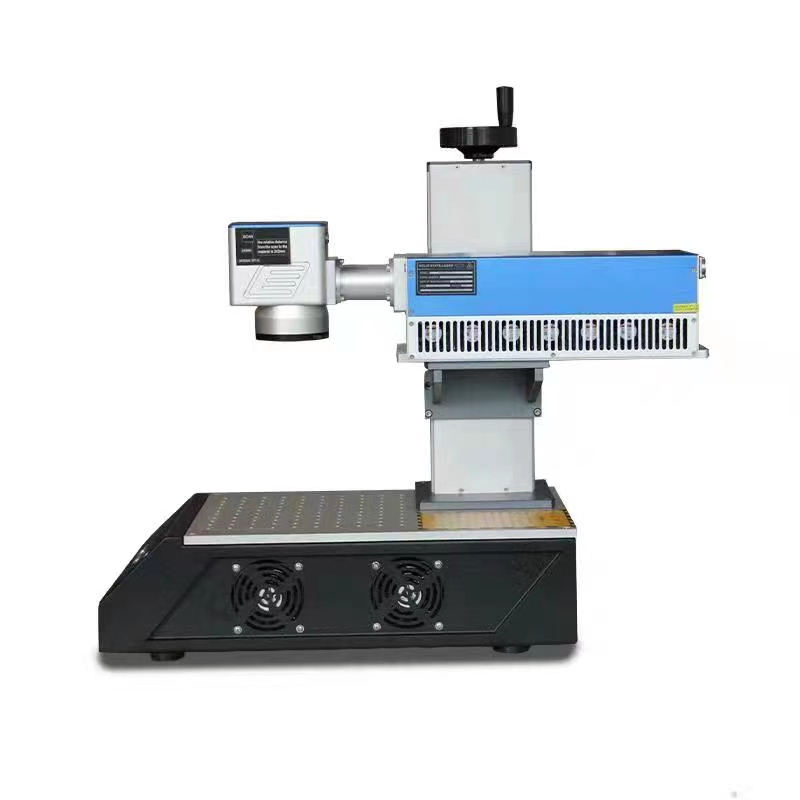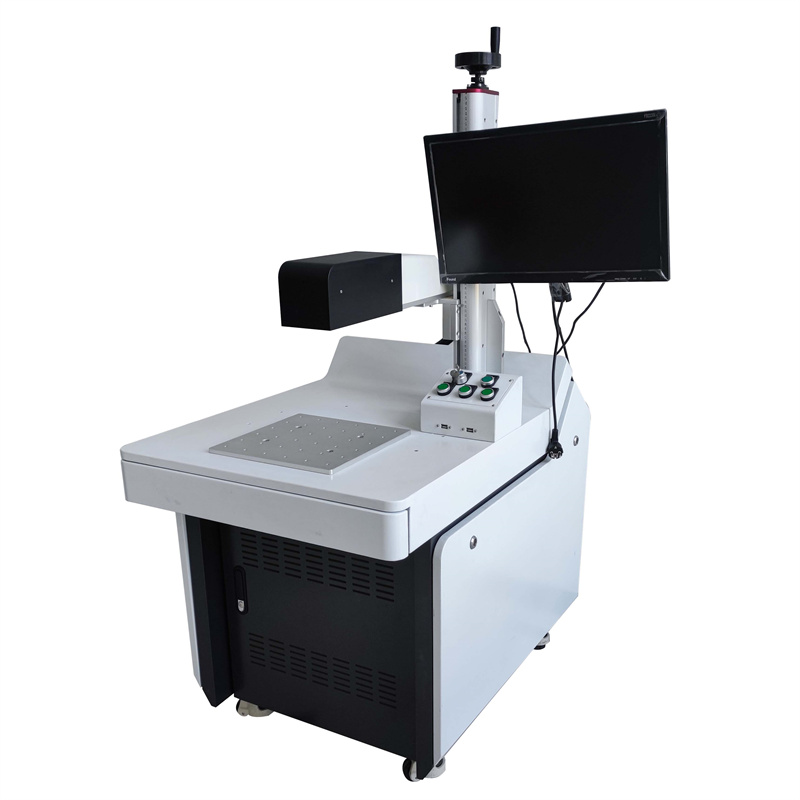In the dynamic landscape of modern manufacturing and product identification, UV laser marking machines have emerged as a revolutionary technology, offering unparalleled precision and versatility. This article delves into the intricacies of UV laser marking machines, exploring their working principles, advantages, applications, and the impact they have had on various industries.
1. Understanding the Basics of UV Laser Marking Machines
1.1 What is a UV Laser Marking Machine?
A UV laser marking machine is a sophisticated device that utilizes ultraviolet (UV) laser beams to create permanent marks, engravings, or etchings on a wide range of materials. These machines are designed to deliver high-energy UV photons, which interact with the material’s surface at a molecular level, resulting in precise and durable markings.
1.2 How Do They Work?
The working principle of a UV laser marking machine is centered around the photochemical reaction induced by the UV laser beam. When the high-energy UV photons strike the material’s surface, they break the molecular bonds of the material, causing a chemical change. This process, often referred to as “cold marking,” is distinct from traditional marking methods that rely on heat or mechanical means. As a result, UV laser marking can achieve high precision and minimal thermal damage to the material, making it ideal for delicate or heat-sensitive applications.
2. The Advantages of UV Laser Marking Machines
2.1 High Precision and Resolution
One of the most significant advantages of UV laser marking machines is their ability to achieve extremely high precision and resolution. The small wavelength of UV lasers allows for the creation of fine and intricate markings, down to the micron level. This makes them particularly suitable for applications that require detailed and high-definition markings, such as microelectronics, jewelry, and medical device manufacturing.
2.2 Non-contact Marking
UV laser marking is a non-contact process, which means that there is no physical contact between the marking tool and the material being marked. This eliminates the risk of mechanical damage, wear, or contamination that can occur with traditional marking methods. Non-contact marking also enables the marking of delicate or fragile materials without the need for additional handling or support.
2.3 Permanent and Durable Markings
UV laser markings are highly resistant to fading, wear, and environmental factors, ensuring long-term durability and legibility. The chemical changes induced by the UV laser beam create a permanent bond with the material, making the markings suitable for applications where long-term traceability and identification are crucial. This is especially important in industries such as aerospace, automotive, and pharmaceuticals, where product integrity and traceability are strictly regulated.
2.4 Versatility in Material Compatibility
UV laser marking machines can be used on a wide variety of materials, including plastics, metals, ceramics, glass, and even some organic materials. This versatility makes them a popular choice for manufacturers who need to mark different types of products or materials. Additionally, UV lasers can be adjusted to optimize the marking process for specific materials, ensuring optimal results and minimal waste.
2.5 Low Maintenance and High Efficiency
UV laser marking machines are known for their low maintenance requirements and high efficiency. The solid-state UV lasers used in these machines have a long lifespan and require minimal servicing, reducing downtime and maintenance costs. Moreover, the high-speed marking capabilities of UV laser machines enable manufacturers to increase production throughput and meet tight deadlines.
3. Applications of UV Laser Marking Machines
3.1 Electronics and Semiconductor Industry
In the electronics and semiconductor industry, UV laser marking machines are widely used for marking components, circuit boards, and semiconductor wafers. The high precision and resolution of UV lasers allow for the marking of small and intricate details, such as part numbers, serial numbers, and barcodes. UV laser marking also ensures the long-term durability and legibility of markings, which is essential for product traceability and quality control in this industry.
3.2 Medical and Pharmaceutical Industry
The medical and pharmaceutical industry has strict requirements for product identification and traceability. UV laser marking machines are used to mark medical devices, pharmaceutical packaging, and drug containers with important information such as lot numbers, expiration dates, and dosage instructions. The non-contact and sterile nature of UV laser marking make it suitable for use in this industry, as it minimizes the risk of contamination and ensures the integrity of the products.
3.3 Automotive Industry
In the automotive industry, UV laser marking machines are used for marking various components, including engine parts, transmission components, and automotive electronics. The permanent and durable markings provided by UV lasers are crucial for product identification, recall management, and quality control in this industry. Additionally, UV laser marking can be used to mark parts with unique identifiers, such as QR codes, which can be used for inventory management and supply chain tracking.
3.4 Jewelry and Luxury Goods Industry
The jewelry and luxury goods industry values precision, craftsmanship, and attention to detail. UV laser marking machines are used to mark precious metals, gemstones, and luxury products with intricate designs, logos, and serial numbers. The high-resolution capabilities of UV lasers allow for the creation of detailed and visually appealing markings, enhancing the aesthetic value and authenticity of these products.
3.5 Packaging and Labeling Industry
In the packaging and labeling industry, UV laser marking machines are used to mark product packaging, labels, and cartons with important information such as product names, ingredients, and usage instructions. The non-contact and high-speed marking capabilities of UV lasers make them suitable for use in high-volume production environments, ensuring efficient and accurate marking of packaging materials.
4. Choosing the Right UV Laser Marking Machine
When selecting a UV laser marking machine, several factors need to be considered to ensure that it meets the specific requirements of your application. These factors include:
4.1 Power and Wavelength
The power and wavelength of the UV laser are important considerations, as they determine the marking speed, depth, and quality. Higher power lasers are generally more suitable for marking thicker or more durable materials, while lower power lasers may be sufficient for marking delicate or thin materials. The wavelength of the UV laser also affects the material compatibility and the type of markings that can be achieved.
4.2 Marking Area and Resolution
The marking area and resolution of the UV laser marking machine should be selected based on the size and complexity of the markings required. Larger marking areas are suitable for marking larger products or materials, while higher resolution capabilities are necessary for creating fine and intricate details.
4.3 Software and Control System
The software and control system of the UV laser marking machine should be user-friendly and easy to operate. It should also offer a wide range of features and functions, such as the ability to create and edit marking designs, control the laser parameters, and interface with other production equipment.
4.4 Compatibility with Materials
Ensure that the UV laser marking machine is compatible with the materials you intend to mark. Different materials may require different laser parameters and marking techniques to achieve optimal results.
4.5 Cost and Return on Investment
Consider the cost of the UV laser marking machine, including the initial purchase price, maintenance costs, and operating costs. Evaluate the potential return on investment by considering factors such as increased production efficiency, improved product quality, and reduced waste.

5. Future Trends in UV Laser Marking Technology
As technology continues to advance, the future of UV laser marking machines looks promising. Some of the key trends that are expected to shape the development of this technology in the coming years include:
5.1 Increased Precision and Miniaturization
The demand for even higher precision and smaller markings is expected to drive the development of UV laser marking machines with improved resolution and beam quality. This will enable the marking of even smaller components and the creation of more intricate designs, opening up new opportunities in industries such as microelectronics and nanotechnology.
5.2 Integration with Industry 4.0
UV laser marking machines are likely to become more integrated with Industry 4.0 technologies, such as the Internet of Things (IoT), artificial intelligence (AI), and machine learning (ML). This will enable real-time monitoring, control, and optimization of the marking process, as well as the collection and analysis of data for predictive maintenance and quality control.
5.3 Expansion of Material Compatibility
Research and development efforts are focused on expanding the range of materials that can be marked with UV lasers. This includes the development of new laser sources and marking techniques that are compatible with challenging materials, such as composites, polymers, and flexible substrates.
5.4 Sustainable and Energy-efficient Solutions
With the growing emphasis on sustainability and energy efficiency, UV laser marking machine manufacturers are expected to develop more environmentally friendly and energy-efficient solutions. This may include the use of more efficient laser sources, the optimization of power consumption, and the reduction of waste and emissions.
In conclusion, UV laser marking machines have revolutionized the way products are marked and identified in various industries. Their high precision, non-contact marking, permanent durability, and versatility make them an ideal choice for a wide range of applications. As technology continues to evolve, UV laser marking machines are expected to become even more advanced, offering increased precision, integration with Industry 4.0, expanded material compatibility, and sustainable solutions. Whether you are in the electronics, medical, automotive, jewelry, or packaging industry, UV laser marking machines can provide the high-quality markings and efficient production capabilities that your business needs.



